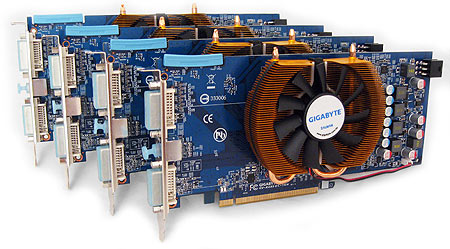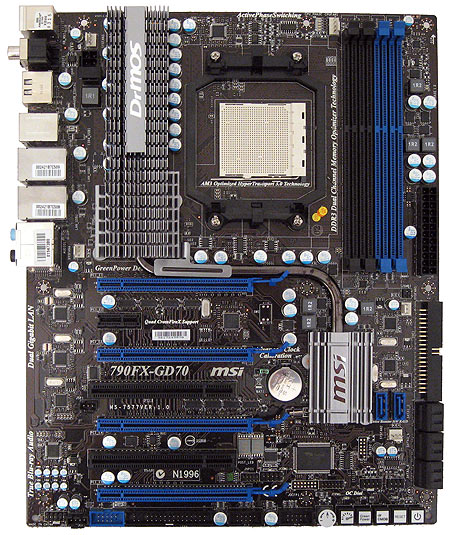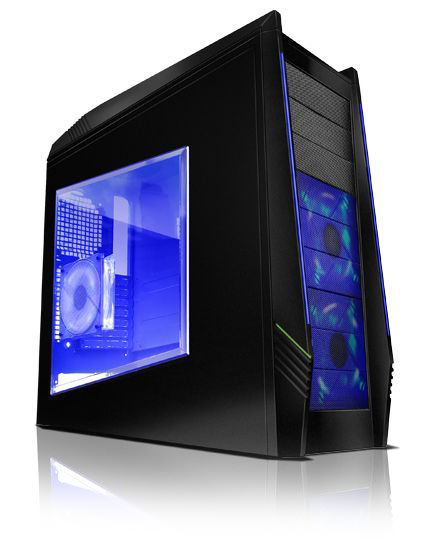System Builder Marathon, Sept. '09: $1,250 Enthusiast Build
Video Cards, Motherboard, And Case
Video Cards: 4 x Gigabyte GV-R485OC-1GH in CrossFire
This was the choice that shaped the build, which is obviously the most controversial component in the list. Why did I choose four Radeon HD 4850s? Let me guide you through the thought process.
I wanted to make this AMD box a formidable gaming machine, and to do that, I needed to consider some real horsepower. In fact, I originally tried to fit two Radeon HD 4870 X2 cards into the budget. I could have made it work, but the tradeoffs would have been hard to live with: we would have had to settle for a dual-core Phenom II X2 550 or a triple-core Phenom II X2 710 to make it workable. In addition, we would have had to spec out a monster power supply capable of handling a pair of mammoth Radeon HD 4870 X2 cards.
The next logical step was to use four 512MB Radeon HD 4870s instead, to save money. This allowed us to budget a true quad-core Phenom II, a better motherboard, and a nicer case. Unfortunately, we couldn't find a suitable PSU at a reasonable price that we were confident could handle our quartet of Radeon HD 4870s. Remember that each card would require two PCI Express (PCIe) power cables just to run the graphics subsystem alone. Yes, we could have used molex-to-PCIe adapters, but we weren't confident it would be a good choice for a stable system, because we didn't have all the money in the world to spend on a top-tier power supply.
Then it occurred to us: why not use Radeon HD 4850s? This choice would allow us to get cards with 1GB of memory instead of 512MB, and we could get overclocked models that would perform closer to the Radeon HD 4870s we craved while remaining within our budget. Lo and behold, we found Gigabyte's GV-R485OC-1GH, and it fit the bill so nicely:
Read Customer Reviews of Gigabyte's GV-R485OC-1GH
With a 700 MHz core clock rate (versus the reference 625 MHz) and a full gigabyte of memory (not to mention a nice, quiet aftermarket cooler) each GV-R485OC-1GH gave us just what we needed at a low $120 price tag.
Get Tom's Hardware's best news and in-depth reviews, straight to your inbox.
Will four of them provide epic gaming leetness? For the price, maybe. We're well aware that CrossFire provides diminishing returns as we scale up, especially past two cards. It might turn out that we could have been better served by two Radeon HD 4890s. It might turn out that the low-end pair of Radeon HD 4850s in CrossFire matches the system's performance due to driver limitations. But you know what? We're doing it anyway, just because we want to see what it can do.
Motherboard: MSI 790FX-GD70
Read Customer Reviews of MSI's 790FX-GD70
We weren't kidding when we said the decision to go with four graphics cards heavily affected every choice thereafter. For example, it was the MSI 790FX-GD70 or nothing, as we couldn't find any other motherboard that would provide the usable space for four dual-slot Radeons in CrossFire.
Sure, there were other boards with four PCIe slots out there, but most of them will only realistically handle three dual-slot graphics cards because of the way the slots are spaced. But just because we didn't have a choice doesn't mean we were disappointed. The 790FX chipset is ideal for our purposes, and MSI's board has an excellent reputation as an enthusiast piece. At $165, it ate up a good chunk of our budget, but it was worth every penny.
Chassis: NZXT Tempest Mid-Tower Case
Read Customer Reviews of NZXT's Tempest Chassis
Now that we have a motherboard and graphics card, where are we going to put them? Our experience has shown us that the NZXT Tempest is a great case with a lot of airflow. But more importantly for this specific application, it offers a lot of space for graphics cards. Even with the power supply mounted below the ATX-sized motherboard, the Tempest leaves us more room than a lot of its competitors, which makes it an easy pick. The $100 price tag is reasonable, too.
Current page: Video Cards, Motherboard, And Case
Prev Page System Builder Marathon: $1,250 AMD System Next Page Power Supply, CPU, And CoolerDon Woligroski was a former senior hardware editor for Tom's Hardware. He has covered a wide range of PC hardware topics, including CPUs, GPUs, system building, and emerging technologies.
-
gkay09 I would have preferred the i7 860 paired with 2x HD 4890s or 2x GTX 275s or even a single HD 5870 for this budget...Reply -
frozenlead gkay09I would have preferred the i7 860 paired with 2x HD 4890s or 2x GTX 275s or even a single HD 5870 for this budget...Reply
I agree. I mean, props for quadfire, but it's not really the best choice for the best performance. -
HibyPrime Even though it turned out to only be faster at high resolution gaming, I have to commend you guys for skipping the obvious here.Reply
An i5 750 build probably would have turned out better numbers on the whole, I would probably call this a last hurrah (and the $2500 too, im sure that'll be a quad) for quad CF/SLi based systems being used to run a single 30" monitor.. I'm sure we'll start to see the high end gamers moving over to eyefinity and whatever equivalent nVidia comes up with. -
gkay09 But as this is an all-AMD build, the X4 955 would have been a better choice...And did you people come across any driver issues when dealing with Quad-crossfire ?That setup looks like asking for trouble...Reply -
IzzyCraft 4 x Gigabyte GV-R485OC-1GH Radeon HD 4850 in CrossFireReply
Interesting but frankly not a huge fan of multi gpu set ups to being with let alone a quad fire set up i mean at least with nvidia you have decent scaling, but who am i to complain for that price and it seems to run high rez just fine.
But that is a *** load of load power draw, noise(not too much nice zalman heat sinks on those cards) and heat coming out of that thing.
bit surprised when i saw the load Wattage you got i thought the older 1300 rig was a i7 with 2x260's in sli which should come out to be less power draw under load even with a modded 4870 cards
Little risky build but on the bright side you could run 8 monitors lol
Conventional would have landed this price in the i5/i7 build with 2x4890's or a bit more powerful cards really depends on which cpu you settle with. Ofc ionno how long ago you order this. Would have came out a bit more rounded but not as great for higher resolutions and AA AF settings.
This build is more of a high resolution gaming specialist. Personally i've never built a system with just gaming in mind i've always been a man that favors a more rounded system where you spend at least 3/4th of what you put into your gpu into your cpu
Thomas Soderstrom's $2,500 AMD build tomorrow
bah $2,500 and no i7 not like the budget couldn't fit very expensive gpu card and cpu in there. Oh well it wont loose out too much in games even with mutli gpu set ups...best have a sound card in there it be very refreshing for tom's builds to sport one. Interesting what monstrosity he has made to share with us. -
jj463rd I agree with gkay09 on spending the extra $20 and going with the Phenom II X4 955 BE instead even if it pushes the budget a little over.At this price level I would probably choose a Core i7 build though.I really liked the $650 SBM budget AMD build that was a great choice.Reply -
Proximon Heh well, not all SBMs have to be perfect. I'm liking the whole experimental phase the SBMs are going through. More educational than just seeing a build I would have done myself.Reply -
IzzyCraft jj463rdI agree with gkay09 on spending the extra $20 and going with the Phenom II X4 955 BE instead even if it pushes the budget a little over.At this price level I would probably choose a Core i7 build though.I really liked the $650 SBM budget AMD build that was a great choice.Well it was by demand to make AMD builds and this is what happens they timed it just right to be right after i5 release just to mess with us. AMD builds shouldn't hurt in games but in apps depending it can be murder or breaking even.Reply






